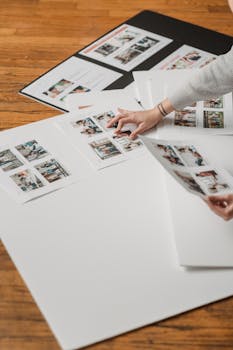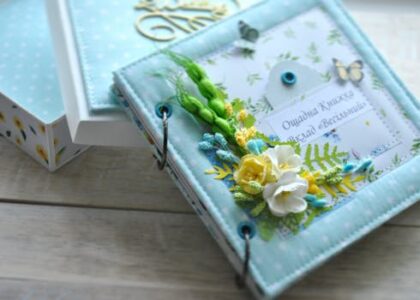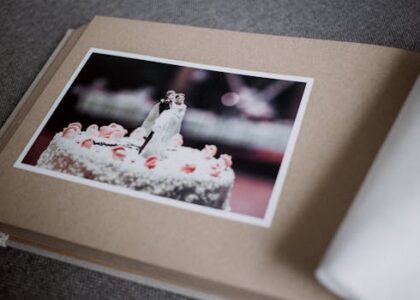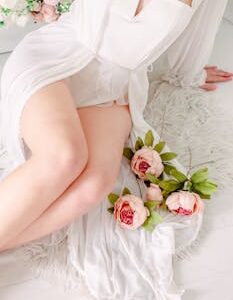As an Amazon Services LLC Associates Program participant, we earn advertising fees by linking to Amazon, at no extra cost to you.
The Role of Storytelling in Wedding Photo Albums
Storytelling is the heartbeat of wedding photo albums. It’s not just about pretty pictures; it’s about capturing the essence of a couple’s journey. Each image should evoke feelings, memories, and connections that tell their unique story.
Many photographers lean toward a documentary-style approach. They believe that real moments, not posed ones, create the most authentic narratives. But I think there’s magic in orchestrating some moments too. A mix of candid and curated shots can really enhance the emotional depth.
Some argue that composition rules are essential for storytelling. Sure, the rule of thirds and leading lines are helpful. But breaking those rules can lead to unexpected and dynamic images that truly capture the spirit of the day. Off-centering subjects or using asymmetry can evoke spontaneity and excitement.
Light plays a significant role in setting the mood. Natural light is often praised, but I believe that playing with shadows can add a layer of intrigue. Shadows can illustrate moments of intimacy and reflect emotions in a subtle way.
Editing is where the story can really come alive. Applying filters can transport viewers back in time, while cohesive color grading can tie the album together. The right editing style can transform a collection of photos into a heartfelt narrative.
Incorporating thematic elements that resonate with the couple’s story adds depth. Personal artifacts or meaningful locations can serve as powerful storytelling devices. As Henry Tieu puts it, “I’m drawn towards the history of the venue along with the personalities of the couple”. This perspective can elevate the narrative to new heights.
So, let’s rethink how we approach wedding photography. It’s about weaving a tale that couples will cherish forever. The art of storytelling is what makes wedding albums unforgettable.
How Thematic Elements Enhance Storytelling
Thematic elements can add a rich layer to wedding photo storytelling, making each image resonate on a personal level.
- Personal artifacts tell a story. Using items like a family heirloom or a favorite book creates meaningful connections.
- Locations matter. Shooting at places that hold significance for the couple deepens the narrative.
- Shared experiences shine through. Capturing moments that reflect the couple’s journey adds authenticity to the album.
- Colors can evoke emotions. Choosing color palettes that reflect the couple’s personalities enhances the storytelling vibe.
- Candid moments are gold. Unscripted interactions often reveal the couple’s true feelings, making the story relatable.
- Most photographers think thematic consistency is key. I believe diversifying themes can create unexpected narratives that surprise and delight.
- Some argue that every photo should match the theme. I think breaking this can add a layer of spontaneity and excitement.
Apr 27, 2024 … Want to see the magic of candid moments in your wedding album? … Fine Art + Visual Narrative Photographer | Substack Author. 2mo.
Sontag: On Photography and Schaverien | Mark Wheeler posted on …
Techniques for Capturing Authentic Moments
Most photographers think posed shots are the way to go. I believe candid moments tell a richer story. Capturing genuine emotions, like laughter or tears, creates a connection that resonates.
Using a documentary-style approach is a game changer. It allows the day to unfold naturally. You’re not just snapping photos; you’re telling a story, one moment at a time.
Consider incorporating thematic elements that reflect the couple’s journey. Locations or personal artifacts can add depth to your images. It’s not just about the couple; it’s about their world.
Henry Tieu from Henry Tieu Photography says, “As a storyteller, I’m drawn towards the history of the venue along with the personalities of the couple.” This perspective can transform how you capture the day.
Some photographers capture real-time moments, waiting for spontaneous interactions. This approach feels more organic. It’s all about being a quiet observer rather than a director.
Incorporating emotional connections is key. Focus on interactions that reflect love and joy. These moments create an album that viewers can connect with on a deeper level.
Don’t shy away from experimenting with composition. Breaking the rules can lead to unique narratives. Off-centering subjects or using asymmetry can evoke spontaneity.
So, let’s rethink how we approach wedding photography. It’s about capturing the essence of the day, not just the events. When you focus on authenticity, the results are magical.
Top Storytelling Techniques for Wedding Photos
Here are some impactful techniques to elevate storytelling in your wedding photo albums.
- Capture candid moments. These fleeting expressions tell the real story of the day.
- Utilize composition techniques. The rule of thirds and leading lines guide the viewer’s eye.
- Play with light. Golden hour creates a magical atmosphere that enhances emotions.
- Focus on emotional connections. Capture laughter, tears, and intimate exchanges for deeper resonance.
- Experiment with thematic elements. Locations or personal artifacts can add layers to your narrative.
- Consider a documentary-style approach. Allow moments to unfold naturally rather than orchestrating them.
- Editing can shape the story. Filters and color grading can evoke nostalgia or enhance mood.
- Break compositional rules. Off-centering subjects can create spontaneity and a sense of action.
- Use shadows creatively. They can add drama and intrigue to your storytelling.
- Capture the venue’s ambiance. It reflects the couple’s journey and enhances the overall narrative.
Benefits of a documentary-style approach
A documentary-style approach to wedding photography captures the raw essence of the day. Here are the key benefits of this technique:
- Authenticity shines through. Documentary-style photography captures real, unscripted moments. This approach allows emotions to flow naturally.
- Less interference. Photographers blend into the background, allowing moments to unfold without interruption. Couples can enjoy their day without feeling staged.
- Tells a complete story. This style documents the entire event, creating a narrative arc. Each photo contributes to the overall tale of love and celebration.
- Captures candid emotions. Genuine reactions and interactions are preserved in their truest form. These images evoke nostalgia and warmth for years to come.
- Highlights relationships. The focus is on connections between family and friends. This adds depth and richness to the wedding album.
- Flexible shooting. Photographers can adapt to changing moments. This flexibility allows for spontaneous captures that traditional poses might miss.
- Creates a timeless feel. Documentary-style images often feel more timeless than posed shots. They resonate with authenticity and emotional truth.
Exploring Various Editing Styles and Their Effects
Editing styles can completely change the feel of wedding photos. Many photographers lean towards heavy editing, believing it adds polish. But I think less is often more. Minimal editing showcases raw emotions, making the moments feel genuine.
Some argue that filters can enhance nostalgia. I disagree. Filters can distort the true essence of the day. Authenticity should shine through without heavy manipulation.
For instance, color grading can unify an album’s aesthetic. But overdoing it can lead to a loss of individuality. Each moment deserves to stand out in its own right.
Many believe that vintage styles are the go-to for wedding photos. But I think modern and vibrant edits can tell a compelling story too. They capture the joy and energy of the day, bringing it to life.
Let’s not forget about thematic edits. Some photographers incorporate elements that reflect the couple’s story. This adds depth and personality to the album, making it uniquely theirs.
As Henry Tieu puts it, “As a storyteller, I’m drawn towards the history of the venue along with the personalities of the couple.” It’s about blending the couple’s essence with the artistry of photography. See more from Henry Tieu Photography.
So, what’s the takeaway? Editing can be a powerful storytelling tool. Choose your style wisely, and let the moments speak for themselves.
The Impact of Composition on Narrative
Composition is the backbone of storytelling in wedding photography. It shapes how viewers perceive each moment. Using techniques like the rule of thirds can create a balanced frame, drawing attention to the couple’s emotions.
Many photographers stick to traditional methods, but I believe breaking the rules can yield stunning results. Off-centering subjects can evoke spontaneity. This approach captures the essence of real-time action, making the moments feel alive.
For instance, think about a bride walking down the aisle. A well-placed leading line can guide the viewer’s eye right to her. Good composition transforms a simple shot into a powerful story.
Some might argue that strict adherence to compositional rules is necessary for professional photography. But I think that embracing imperfection adds character. It can create a more authentic narrative.
Using depth of field strategically can also enhance storytelling. By blurring the background, the focus remains on the couple, amplifying their emotions. This technique adds layers to the narrative.
So, while many stick to the basics, I advocate for creativity. Experimenting with composition can lead to breathtaking results. According to Bailey Quinlan from Bailey Q Photo, “My photography style is creative & photojournalistic, with a colorful yet moody edge.” This kind of approach can truly elevate wedding storytelling.
Using Light to Create Emotional Depth
Many photographers believe natural light is the holy grail of wedding photography. But I think there’s more to it. Artificial light can add a level of control that natural light simply can’t provide. It allows for mood creation and emotional depth.
Golden hour is beautiful, no doubt. But what about the magic that can happen under twinkling string lights? The soft glow can create an intimate atmosphere that enhances emotional connections. According to Henry Tieu, “As a storyteller, I’m drawn towards the history of the venue along with the personalities of the couple.” This highlights how light can tell a story.
Some photographers stick to traditional lighting techniques. They think shadows are something to avoid. I disagree; shadows can add drama and intrigue. Playing with shadows can illustrate moments of intimacy, creating a narrative that feels alive.
While most focus on bright images, I find beauty in contrast. Darker, moodier photos can evoke stronger emotions. It’s all about how light interacts with the scene. Each flicker and shadow tells a part of the story.
So, let’s not limit ourselves to just natural light. Mixing it up can lead to stunning results. After all, the goal is to capture the essence of the day, right?
May 1, 2018 … This is more for the album, but shoot multiple frames in the … place them together on a page to tell a story. Use Back-Button Focus …
PUBLISHED's profile picture. PUBLISHED. LIFE's profile picture. LIFE. INFORMATION's profile picture. INFORMATION. ALBUMS's profile picture. ALBUMS.
Fine Art Wedding Photographer – Love Your Story Photography …
Dec 14, 2020 … I absolutely love making printed art with wedding photos; I think … Tessa and Michael picked a blush leather cover for their wedding photo album …
Sep 19, 2023 …Wedding Album #01 – Design Template Place … "Discover the art of storytelling with our meticulously crafted wedding Album Designs.
As an Amazon Services LLC Associates Program participant, we earn advertising fees by linking to Amazon, at no extra cost to you.
How does light affect the storytelling in photography?
Most photographers think natural light is the best choice for storytelling. I believe artificial light can be just as powerful. It offers control and flexibility, allowing for creative effects that natural light can’t always provide.
Golden hour is often praised, but what about the drama that shadows can create? Using shadows can add depth and intrigue to images, enhancing the narrative in unexpected ways. According to Henry Tieu, ‘As a storyteller, I’m drawn towards the history of the venue along with the personalities of the couple.’
Many focus solely on bright, airy images, but I think there’s beauty in the contrast. Playing with light and shadow can evoke emotions that resonate more deeply. It’s about creating a mood, not just capturing a moment.
Incorporating both forms of lighting allows for a richer narrative. This approach showcases the couple’s story through varied emotional landscapes, making the final album more engaging.
How can I capture authentic moments during a wedding?
Capturing authentic moments is all about being present. I often find that the best shots happen when you blend into the background. Candid interactions reveal true emotions.
Many photographers focus on posed shots, but I think spontaneity is key. Look for laughter, tears, and those fleeting glances. These moments tell the real story.
Consider using a documentary-style approach. This means letting moments unfold naturally rather than orchestrating them. As Cassie Schneider from Cassie Nichole Photography puts it, “Photography allows me to freeze moments in time, capturing the raw emotions and genuine expressions of love.”
Think about thematic elements too. Incorporate locations or objects that mean something to the couple. It’s a way to deepen the narrative and make it personal.
Some photographers believe that capturing everything is essential. I think focusing on key moments creates a more impactful story. You don’t need to document every detail; just the ones that matter.
What makes storytelling important in wedding photography?
Storytelling is the heartbeat of wedding photography. It’s not just about pretty pictures but capturing the essence of the day. Each moment tells a story, from tears of joy to laughter shared with friends.
Many believe that posed shots are key. I think candid moments are where the magic happens. Those unguarded expressions reveal genuine emotions that resonate deeply.
Photographers often focus on the big moments. But I feel that the small details matter just as much. A gentle touch, a knowing glance—these are the threads that weave a rich narrative.
Composition plays a role too. Using techniques like the rule of thirds can guide the viewer’s eye, making the story unfold beautifully. But breaking the rules can create unexpected, dynamic images that feel alive.
Light is another storyteller. The golden hour casts a dreamy glow, transforming ordinary moments into something extraordinary. Shadows can add depth and intrigue, revealing layers of emotion.
Editing shapes the final narrative. Some opt for a vintage feel, evoking nostalgia. Others prefer a natural look, showcasing raw emotions without manipulation.
As Henry Tieu says, “As a storyteller, I’m drawn towards the history of the venue along with the personalities of the couple.” See more from Henry Tieu’s perspective.
What compositional techniques should I use for storytelling?
Composition is everything in wedding photography. Using the rule of thirds can guide the viewer’s eye effectively. It’s not just about where you place the couple but how you frame the entire scene.
Leading lines can draw attention to key moments, like the bride walking down the aisle. Framing your subjects with natural elements adds depth to the story. Think about how elements like trees or arches can create a beautiful border.
Some photographers stick to traditional rules, but I believe breaking them can lead to unique stories. Off-centering your subjects can evoke spontaneity and excitement. It’s about capturing the day’s real emotions, not just staged moments.
As Bailey Quinlan from Bailey Q Photo says, “My photography style is creative & photojournalistic, with a colorful yet moody edge.” This reflects how composition can enhance storytelling.
Don’t forget to play with depth of field! Blurring backgrounds can make your subjects pop, focusing the viewer’s attention where it matters most. It’s all about telling a story that resonates.
What editing styles are best for wedding photo storytelling?
Many photographers stick to vibrant edits for wedding photos. But I believe a more muted, vintage style tells a deeper story. It evokes nostalgia and captures the essence of the day.
Some argue that bright and colorful images are more appealing. Yet, I think that subtle tones can create a more intimate atmosphere. As Henry Tieu from Henry Tieu Photography puts it, “As a storyteller, I’m drawn towards the history of the venue along with the personalities of the couple.” This perspective highlights how editing shapes the narrative.
Also, some photographers favor minimal editing. They argue it preserves authenticity. But I think a well-thought-out edit can enhance the story without losing its essence. It’s about finding that perfect balance.
In the end, the best editing style is one that resonates with the couple’s personality. Choose colors and tones that reflect their journey. That’s what makes the album truly special.
Storytelling transforms ordinary wedding photos into unforgettable memories. It’s more than just capturing moments; it’s about weaving a narrative. Each image should evoke emotions and resonate with viewers.
Many photographers think posed shots are the way to go. But I believe in candid, real-time moments. They tell a richer story that reflects genuine connections.
Lighting plays a key role too. Golden hour can create magic, but don’t shy away from shadows! They can add depth and intrigue, making the story even more compelling.
Editing isn’t just about aesthetics. It shapes the emotional tone of the album. A vintage filter can turn modern moments into nostalgic treasures.
Most people focus on traditional styles, but I think it’s time to break the mold. Experiment with new techniques that reflect the couple’s unique story. This approach creates a more personal touch.
For more insights, check out what Cassie Schneider from Cassie Nichole Photography says about capturing raw emotions. Also, see what Gold Wing Photography emphasizes about wide-angle shots that enhance storytelling.
Most photographers chase posed perfection. I believe authentic moments are where the magic happens. Real emotions, like laughter and tears, create a deeper connection.
Capturing spontaneous interactions makes the album feel alive. It’s not just about the couple; it’s about everyone sharing in the joy.
Using thematic elements, like personal artifacts, can add layers to the story. According to Henry Tieu, “As a storyteller, I’m drawn towards the history of the venue along with the personalities of the couple” .
Most photographers think bright, direct light is the way to go. But I believe that shadows can tell a story just as well. Playing with light and dark can evoke strong emotions in viewers.
Golden hour is popular, but don’t overlook moody, low-light settings. They create intimacy, drawing viewers into the moment. According to Henry Tieu, ‘I’m drawn towards the history of the venue along with the personalities of the couple.’
Experimenting with light sources can yield stunning results. Try using candles or fairy lights for a soft, romantic effect. This approach can elevate your storytelling beyond the usual.
Composition is everything in wedding photography. It shapes the story you tell. Using the rule of thirds or leading lines can make moments pop. It’s that simple!
Many think traditional framing is the best way. But I believe breaking the rules can create excitement. Off-centered subjects add a dynamic feel.
For instance, capturing a couple off to one side can evoke spontaneity. It’s not just about the couple; it’s about the whole scene. Composition can turn a snapshot into a narrative masterpiece.
As Bailey Quinlan from Bailey Q Photo says, “My photography style is creative & photojournalistic.” That’s how you draw people in!

I’m Marta, a passionate wedding specialist with over 25 years of experience in the wedding and party planning business.









